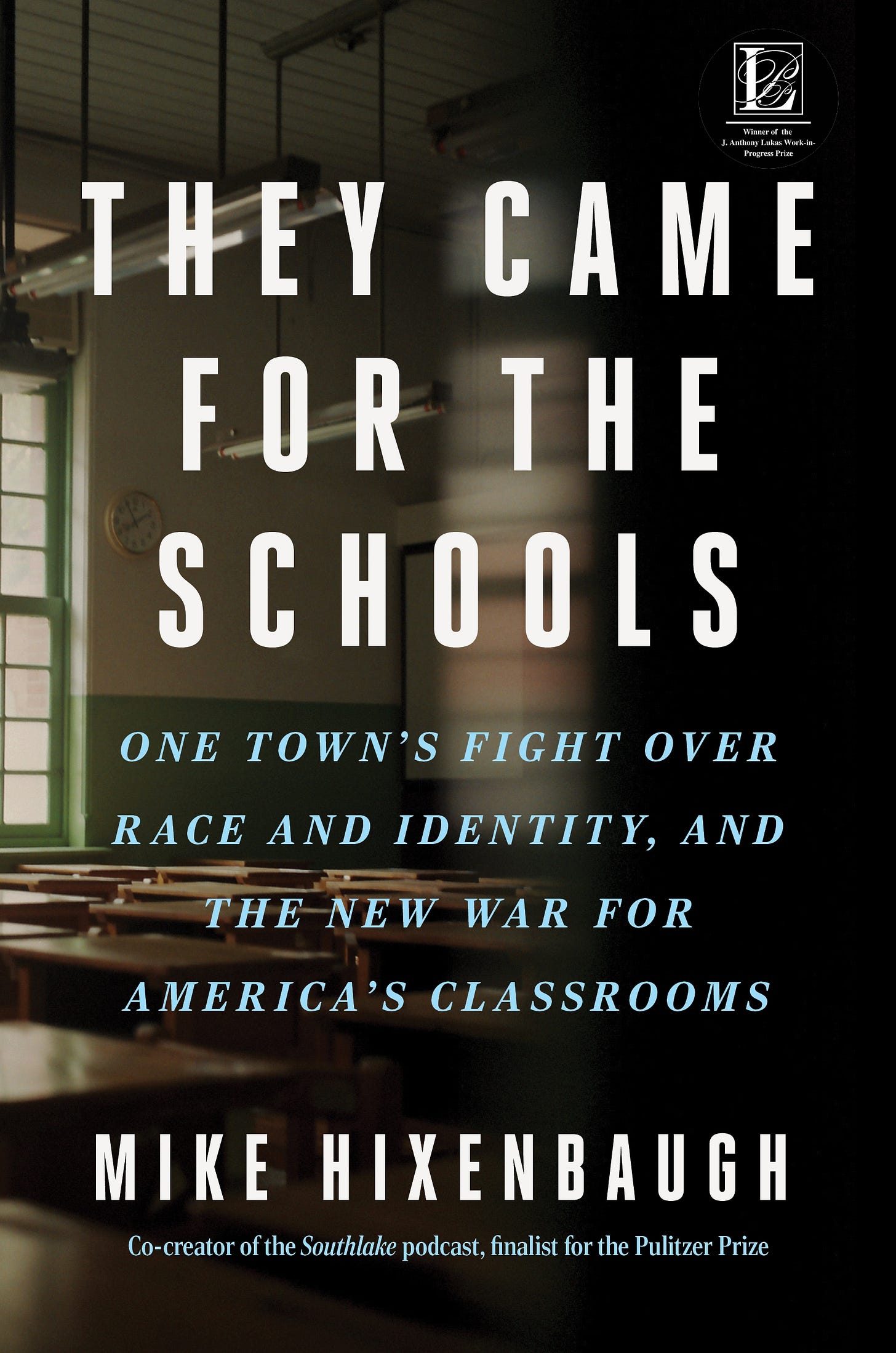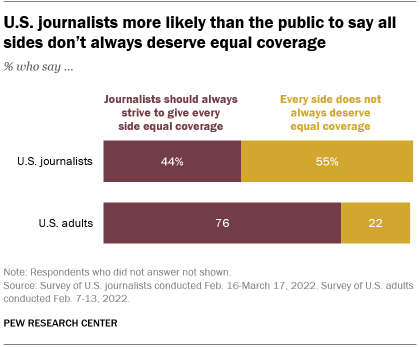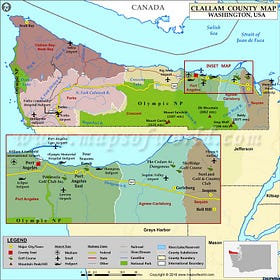"Every side does not always deserve equal coverage"
NBC's Mike Hixenbaugh's new book, "They Came for the Schools," rejects both-sides objectivity to embrace a new model called "trustworthy journalism"
This an early edition of next weekend’s Experiment, your official hopepunk newsletter. If you’d like to support my work, become a paid subscriber or check out the options below. But even if you don’t, this bugga free. Thanks for reading!
Late 2021 was a confusing time to be a public schoolteacher in Texas. All of a sudden, they were worried they could get reprimanded, even fired, for having books in their classrooms that dealt with touchy subjects. The Texas legislature had passed HB 3979 into law requiring teachers to present more than one point of view when discussing controversial subjects, and teachers needed to know what that meant exactly. Like, what do we do with a book about the Holocaust?
In a training session meant to clear that up, one north Texas school district official told anxious teachers, “Just try to remember the concepts of [House Bill] 3979. And make sure that if you have a book on the Holocaust, that you have one that has an opposing, that has other perspectives.”
“How do you oppose the Holocaust?” one teacher asked, meaning, of course, how does one present an opposing view to the prevailing consensus that the Holocaust was, on the whole, bad.
“Believe me,” said the administrator. “That’s come up.”
“How do you oppose the Holocaust?”
“Believe me, that’s come up.”
This probably rings a bell. When NBC’s Mike Hixenbaugh broke the story in Oct. 2021, the “teaching both sides of the Holocaust” made international news and became a tidy example of the ridiculousness of bothsidesism, or the false balance created when the media portrays something more even-handedly than the facts suggest.
“Every side does not always deserve equal coverage,” says Hixenbaugh. “Obviously. I just published an excerpt this week about where that mentality leads.” That excerpt is from They Came for the Schools: One Town’s Fight Over Race and Identity, and the New War for America’s Classrooms, already an Amazon #1 best seller before its Tuesday release date. The book is the latest from Hixenbaugh, a 39-year-old senior investigative reporter for NBC News. He’s also a co-creator of the Peabody Award-winning, Pulitzer Prize-finalist Southlake podcast.
Co-produced with his NBC colleague Antonia Hylton, Southlake reported on the anti-woke blowback in a wealthy, north Texas school district. Well-funded conservatives took over that school board and rolled back anti-racism efforts. In the process they wrote the extremist playbook that was used to take over school boards all across the country. They Came for the Schools now arrives in the middle of another, somewhat related fight over the role of journalism amid a political environment marked by asymmetrical balderdash.
Namely, does objective journalism require giving equal time and weight to “both sides” of an argument even when, as is the case with the Holocaust and climate change, doing so would superimpose an artificial political fight over historical or scientific consensus. And when it comes to the 2024 elections, should equal weight be given to what are called the negatives of Joe Biden and Donald Trump. More to the point, should Biden’s unpopularity and age be propped up in the press as equally important as Trump’s fascist rantings, criminality, and anti-democratic campaign promises?
There is honest disagreement among American journalists on this matter, only a minority of whom think they “should always strike to give every side equal coverage.” Generally speaking, however, younger journalists who write for print or online disagree and say “every side does not always deserve equal coverage.”
Joe Kahn, executive editor of The New York Times, puts a reductio ad absurdum spin on this fight by arguing that it’s not his job to stop Trump from getting elected. In a recent interview, this is how he characterized the alternative to the “objective” journalism that so often comes across as bothsidesism:
We become an instrument of the Biden campaign? We turn ourselves into Xinhua News Agency or Pravda and put out a stream of stuff that’s very, very favorable to them and only write negative stories about the other side? And that would accomplish — what?
In his defense of objective journalism—which Hunter S. Thompson called “a pompous contradiction in terms”—Khan offers the laughable choice of bothsidesism and political propaganda while ignoring that false balance has led to a decrease in trust in the media, science, and civic literacy.
Amid this fight comes Hixenbaugh’s new book that, like the podcasts he did with Hylton, demonstrates a new way forward for journalism — just telling us what is happening. “My job is not to get Joe Biden elected or to get certain school board members elected, although I've been accused of that” he says. “I think in journalism, our priority is to the truth. To me, that is the guiding force that dictates the work we do.”
For someone exhausted with how mainstream journalism has bent over backwards for decades to accommodate bad-faith actors at the expense of accurate representations of reality, They Came For the Schools is a refreshing, if bracing, breath of compressed oxygen. He follows the Holocaust story to its conclusion; the whistleblower, not the administrator, lost her teaching job, and the school board changed policy to ban secret recordings.
And when conservative activists mischaracterized what an anti-racism plan would do, he didn’t present their accusations unchallenged without proper context. In language devoid of the softening qualifiers often found in mainstream news outlets, Hixenbaugh just, well, tells the truth:
“Why would you make them learn that, because I’m a different color than them, that means we aren’t equal, they don’t love me the same?”
But the CCAP didn’t say anything about Black and white children being unequal or not loving each other. Yet Williams’s comment reflected a core belief among many of those opposing the plan. He and others argued children shouldn’t be taught to see color, and that any instruction that emphasized the way racial differences are experienced would only deepen rather than heal divisions.
In The New York Times, this would have been rendered into a two-handed comparison of opposing views. Here, Hixenbaugh quotes a critic, says it’s baseless, but then goes deeper to say that the inaccurate criticism accurately reflects what they believe. Facts are put into the proper perspectives, not balanced.
“Our mission should be to tell the truth, to report the truth, to find the truth without fear or favor. Right? But that includes not giving a pass when we discover that a certain side or perspective is untrue or misleading or false,” says Hixenbaugh. “I think something that is maybe a remnant of that mindset that I strive not to do, but that I see sometimes in reporting, that is the hard edges of the truth of what's happening kind of get shaved off just a little bit. And we don’t use language that is as direct and as to the point as we could. And it’s almost like an effort to try to like soften the reality of what's happening.”
It’s almost like Hixenbaugh doesn’t know he works for a mainstream news outlet. National political reporters aren’t supposed to come out and just say this. But while everyone’s been fighting about bothsidesism, Hixenbaugh and other, mostly younger journalists are part of a generation moving on from the false balance of objective journalism to what Carl Bernstein and Bob Woodward termed “the best obtainable version of the truth.”
The drive toward false balance, of course, was the result of the decades long attack by conservatives on the paper tiger of the liberal media. And it worked. In my former political career, I dealt with a lot of journalists who made it very clear with varying degrees of self-awareness that they didn’t want to be labeled as the liberal media. These attacks have reached a nadir with Trump who famously called journalists “enemies of the people,” but it’s been going on for a long time. That’s how we ended up with the heads-I-win-tails-you-lose status quo of any news story that hurts Republicans or helps Democrats being perceived of as coming from a liberal media, but stories that do the opposite—hurt Democrats, help Republicans—are seen as fair.
To Hixenbaugh, fairness is less a reflection of a systemic structure than a value that guides your work. “Fairness is key,” he says. “If you’re going to write about somebody, you give that person every opportunity to share their perspective, to explain their perspective, to provide documentation to back up whatever claims they might be making. But just because a politician has declared they are the leaders of the parents’ rights movement, does not mean you as a journalist have to adopt that language and treat it as a true statement if it’s not true.”
You might think that Hixenbaugh would have made himself Public Enemy Number One among the far-right, and certainly They Came For the Schools has many examples of people being upset at his coverage. But Hixenbaugh avoids the slanted word choices that could come across as partisan. He’s no name caller. He just reports what the heck is going on, and as it turns out, there might be a market for that on the right, too.
“You seem to actually report the facts about conservative Americans.”
“Just read your extensive article,” began a recent email Hixenbaugh received. “I want to thank you for your honest reporting. Quite frankly as you work for the extremist far left wing activists at NBC News I expected a horrific hit piece on Christians, but what I found instead was actual decent journalism! You seem to actually report the facts about conservative Americans.”
And on his podcast, no less than Steve Bannon, former Trump White House Chief Strategist, marveled at Hixenbaugh’s reporting about a conservative mobile phone company that is funding school board races. “It’s actually pretty accurate,” said Bannon. “It’s a really interesting article, and it goes into quite depth.”
So there you have it. Even Steve Bannon himself endorses the reporting accuracy of Mike Hixenbaugh, out Tuesday with They Came for the Schools: One Town's Fight Over Race and Identity, and the New War for America's Classrooms. Kirkus Reviews calls it “detailed and sharp-edged.” In a starred review, Publishers Weekly calls it “a meticulous debut exposé” and “extraordinarily detailed analysis … a vital work of reportage.”
But Steve Bannon calls it “actually pretty accurate.” Honestly, you’re not going to get a better review of They Came For the Schools from The New York Times.
Jason Stanford is a co-author of NYT-best selling Forget the Alamo: The Rise and Fall of an American Myth. His bylines have appeared in the Washington Post, Time, and Texas Monthly, among others. Follow him on Threads at @jasonstanford, or email him at jason31170@gmail.com.
Further Reading
Despicable Me
OK, Florida, settle down. We see you. First your education board rejected a new AP class in African American studies because, it claimed, the course lacked “educational value.” And now your Governor, bless his pudding-eating heart, signed a law that famously credits slavery for teaching the enslaved skills that “could be applied for their personal benef…
America's Last Bellwether
I don’t get home often enough, but as I hit traffic at a stoplight that wasn’t there when I grew up, I remembered why. The stoplight cycled three times before I got through. I’d gotten up before dawn to take the light rail to the airport, a tram to my gate, a plane from a state on the Mexican border to one on the Canadian border, a shuttle bus to pick u…
My bratty sister-in-law helped me understand why CNN failed
As I write this, my sister-in-law is behind me. Let’s call her Q, which will amuse her. She’s sitting on our big, purple couch, writing something just for herself, and I’m struck by her stillness. She is perfectly quiet, which as anyone related to her can tell you is unusual. Invariably,
The New Tea Party
Welcome to The Experiment, where the only reason we’re not bailing on season two of The Morning Show is Holland Taylor. No spoilers this week as Jack Hughes traces the uncanny similarities between HBO’s Succession and the real-life drama of horrible people, the House of Windsor
We set up a merch table in the back where you can get T-shirts, coffee mugs, and even tote bags now. Show the world that you’re part of The Experiment.
We’ve also got a tip jar, and I promise to waste every cent you give me on having fun, because writing this newsletter for you is how I have fun.
Buy the book Texas Lt. Gov. Dan Patrick banned from the Bullock Texas History Museum: Forget the Alamo: The Rise and Fall of the American Myth by Bryan Burrough, Chris Tomlinson, and myself is out from Penguin Random House. The New York Times bestseller is out in paperback now!








